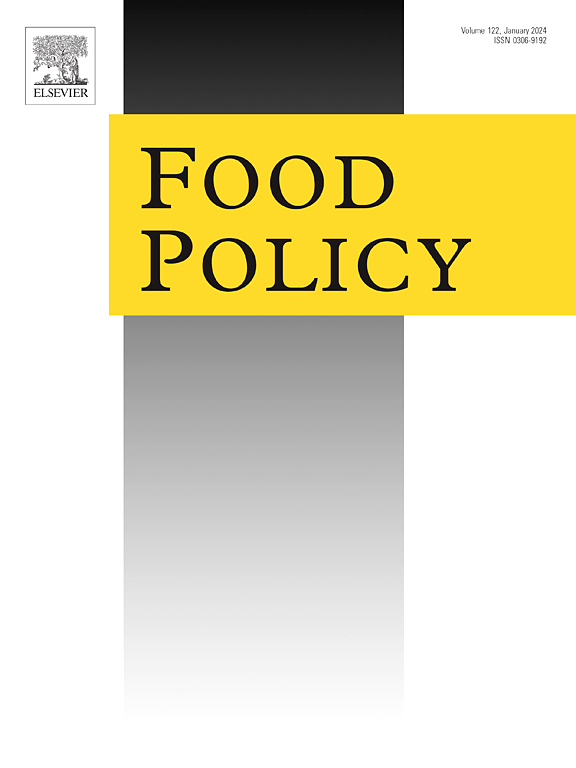Social networks and the demand for credence agricultural technologies
IF 6
1区 经济学
Q1 AGRICULTURAL ECONOMICS & POLICY
引用次数: 0
Abstract
Little is known about the adoption of agricultural technologies that enhance unobservable attributes, such as food quality and food safety. Social networks can potentially be a key tool to disseminate information about such technologies, because informal discussions among network members could counter the lack of observability and awareness of the benefits of such technologies. To inform this issue, we conducted a field experiment that included experimental auctions and a lottery to estimate how social networks influence the demand for Aflasafe, a new food safety-enhancing technology, among smallholder farmers in Senegal. Aflasafe is an agricultural input that controls aflatoxins, which are unobservable carcinogenic compounds that contaminate grains and compromise their safety for human consumption. Despite the lack of any food-safety regulations or price incentives in the study area, we found that demand for Aflasafe was high at baseline after farmers were trained on its benefits. The results show that social networks increased demand for Aflasafe among participants who had a lower willingness to pay in the first period. These individuals likely needed the most convincing to adopt the technology. Further, we find suggestive evidence that having an Aflasafe adopter (“lottery winner”) who used the treated groundnut for own consumption and use as future seed in an individual’s network increases their demand. Having an adopter who used the treated groundnut for other purposes in an individual’s network is not associated with any change in an individual’s demand. These findings suggest that smallholder farmers – who are often both producers and consumers of their food – engage in discussions about technologies with unobservable benefits within their agricultural social networks. Thus, it seems possible, at least in the short term, that these networks can be harnessed to increase technology adoption by leveraging farmers’ concern about their health and food safety.
社会网络与信任农业技术的需求
人们对采用农业技术提高食品质量和食品安全等不可观察属性所知甚少。社交网络可能成为传播此类技术信息的关键工具,因为网络成员之间的非正式讨论可以抵消这种技术的可观察性和对其好处的认识不足。为了了解这一问题,我们进行了一项实地试验,包括实验拍卖和抽奖,以估计社会网络如何影响塞内加尔小农对Aflasafe(一种新的食品安全增强技术)的需求。Aflasafe是一种控制黄曲霉毒素的农业投入物,黄曲霉毒素是一种无法观察到的致癌化合物,会污染谷物并危及人类食用的安全性。尽管研究地区缺乏任何食品安全法规或价格激励措施,但我们发现,在农民接受了有关其益处的培训后,对Aflasafe的需求在基线时很高。结果表明,社交网络增加了参与者对Aflasafe的需求,这些参与者在第一阶段的支付意愿较低。这些人可能需要最大的说服力来采用这项技术。此外,我们发现有暗含的证据表明,如果有一个Aflasafe的采用者(“彩票中奖者”)将处理过的花生用于自己的消费,并将其用作个人网络中的未来种子,则会增加他们的需求。在个人的人际网络中,如果有将处理过的花生用于其他目的的采用者,则与个人需求的任何变化无关。这些发现表明,小农——他们往往既是粮食的生产者,也是粮食的消费者——在他们的农业社会网络中参与了关于技术的讨论,这些技术具有不可观察的好处。因此,至少在短期内,似乎有可能利用这些网络,通过利用农民对其健康和食品安全的关注来增加技术的采用。
本文章由计算机程序翻译,如有差异,请以英文原文为准。
求助全文
约1分钟内获得全文
求助全文
来源期刊

Food Policy
管理科学-农业经济与政策
CiteScore
11.40
自引率
4.60%
发文量
128
审稿时长
62 days
期刊介绍:
Food Policy is a multidisciplinary journal publishing original research and novel evidence on issues in the formulation, implementation, and evaluation of policies for the food sector in developing, transition, and advanced economies.
Our main focus is on the economic and social aspect of food policy, and we prioritize empirical studies informing international food policy debates. Provided that articles make a clear and explicit contribution to food policy debates of international interest, we consider papers from any of the social sciences. Papers from other disciplines (e.g., law) will be considered only if they provide a key policy contribution, and are written in a style which is accessible to a social science readership.
 求助内容:
求助内容: 应助结果提醒方式:
应助结果提醒方式:


